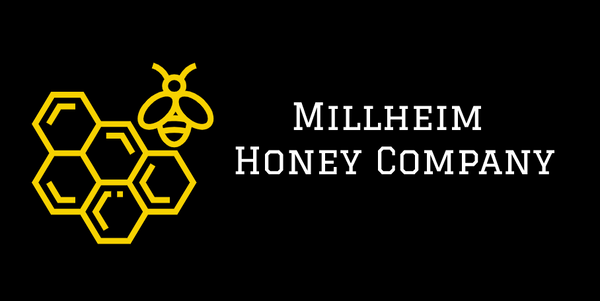
How Honey is Made: From Flower to Jar
Honey is one of nature’s sweetest gifts, but the process of making it is nothing short of incredible. It’s a remarkable journey that involves thousands of bees working together to transform simple nectar into the golden liquid we love. At Millheim Honey Company, we take pride in the bees' hard work, and we want to share with you the fascinating process of how honey is made.
Step 1: Collecting Nectar
Honey production starts when honeybees venture out to gather nectar from flowers. Nectar is a sugary liquid secreted by flowers to attract pollinators. Using their long, tube-like tongues, the bees draw in the nectar and store it in their honey stomachs (also called a crop). This is a special compartment separate from their digestive system, designed specifically for nectar transport.
On each trip, a honeybee can visit up to 100 flowers! Once full, the bee returns to the hive, ready for the next step in the honey-making process.
Step 2: The Transformation Begins
Back at the hive, the nectar isn’t quite honey yet. For that, it needs to be processed. The foraging bee passes the nectar to a worker bee by regurgitating it. The worker bee then takes over, chewing the nectar and mixing it with enzymes from their glands.
This is where the magic starts to happen. The enzymes begin breaking down the complex sugars in nectar into simpler sugars—fructose and glucose. This not only makes the nectar more digestible but also helps it become the thick, sweet substance we know as honey.
Step 3: Drying Out the Nectar
Once the nectar has been enzymatically transformed, it still contains too much water to become honey. Honeybees have a clever solution to this. They spread the nectar across the honeycomb cells, increasing its surface area to allow water to evaporate more easily. The bees then fan their wings over the nectar, creating airflow that further speeds up evaporation.
Over time, the nectar thickens as moisture levels drop. Honey is naturally resistant to bacteria and spoilage, in large part because of its low water content. Once the nectar becomes concentrated enough, it officially turns into honey.
Step 4: Sealing It with Beeswax
When the bees are satisfied that the honey has reached the right consistency, they seal the honeycomb cells with a thin layer of beeswax. This wax cap keeps the honey fresh and protected for future use, whether by the bees themselves or harvested by beekeepers.
Step 5: Harvesting the Honey
At Millheim Honey Company, we carefully remove the wax caps from the honeycomb and extract the honey using a centrifugal extractor, which spins the frames to draw out the honey. We filter the honey to remove any stray bits of beeswax or debris, ensuring it’s pure and ready for your enjoyment.
After extraction, the honey is poured into jars and sealed, ready for sale or use. From its floral origins to the jar on your table, honey’s journey is a labor of love—one that takes teamwork, precision, and plenty of natural sweetness.
Fun Facts About Honey Production
- One bee produces about 1/12th of a teaspoon of honey in its lifetime, but a single hive can make 60 pounds of honey in a year!
- Honey has natural preservative qualities, thanks to its low moisture content and acidic pH, allowing it to last almost indefinitely without spoiling.
- Bees will travel over 55,000 miles and visit more than 2 million flowers to produce just one pound of honey.
At Millheim Honey Company, we understand the importance of healthy, thriving bees. That’s why we work tirelessly to maintain our hives, ensuring the bees are happy and the honey is as natural as possible. The next time you enjoy a spoonful of honey, you’ll know the remarkable effort that went into making every drop!
